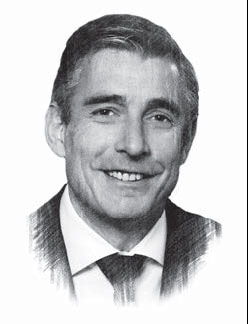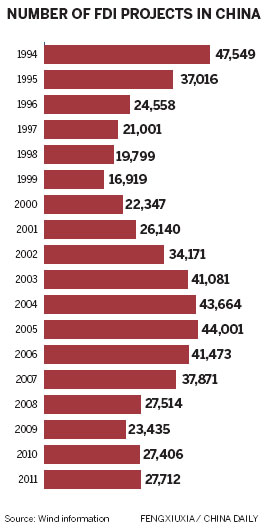Land of opportunities
Updated: 2012-11-08 07:51
(China Daily)
|
|||||||||||
Greg Foran
President & CEO, Wal-mart China
|
 |
1. There is still tremendous growth in China. The country is a market with a vast number of opportunities. We are fully confident about the prospects of the Chinese economy and the Chinese market. In the long term, we want to take Wal-mart China to a whole new level relative to excellence, being able to deliver on food safety, value and even-better stores.
2. We have a continued investment plan in China - we will open more than 100 new stores and more distribution centers in the country in three years, creating 18,000 new jobs. Meanwhile, we are embarking on efforts to continue to address our cost structure. We will continue to focus on the productivity loop, which is part of the Wal-mart culture. It means we will keep improving efficiency and lowering costs and prices to attract more customers to our stores.
We want to improve what we offer to customers by creating a simpler business that is more effective, and so we are embarking on a transformation process of our China operations. We aim to accomplish this by regaining price leadership, growing with a focus on business fundamentals, simplifying the business, investing in the supply chain and technology and developing energized associates.
3. We have a long-term development plan in China and five key business strategies:
Simplify business and optimize operations
Grow, with a focus on business fundamentals
Regain price leadership
Invest in the supply chain and technology
Develop energized associates
The retail industry is undergoing a profound transformation. We want to build an even stronger Wal-mart in China during the next few years and keep ahead of the competition.
4. The transformation is a new growth stage for all retailers, despite various challenges. The biggest challenge for Wal-mart is how to serve our customers locally. Therefore, we will continue to study the needs of our customers and provide them with better, fresh, safer products, lower prices and better services.
5. In the coming years, we see the investment environment, such as laws, regulations and the social environment, becoming more mature. As one of the first retail companies to enter the Chinese market, our development has benefited from the country's opening-up policy.
We are excited to be engaged in the growth of the Chinese economy and society and are willing to cooperate with the government and industrial associations to address the challenges in the industry.
Pam P. Cheng
president, MSD China
|
 |
1. China remains one of the fastest-growing markets in the world. In the healthcare industry, China will become world's second-largest market by 2015, according to an IMS forecast. As such, China remains a critical market for healthcare companies and will remain an important part of MSD's global strategy. MSD has been operating in China for more than 20 years. We have witnessed the incredible growth of China's healthcare market, and we are very proud to have contributed our innovative products and services to improve the health of the Chinese people.
2. MSD has long been committed to China, and our vision is "In China, for China". We share at the deepest level China's vision of making high-quality, affordable healthcare a reality for every citizen. Medicine is for the people and MSD China is committed to making a positive difference in improving the health of the Chinese people. It's certainly true that China represents an important business opportunity, but we've historically found that when we focus on patient health first, the business always follows. MSD will continue to play a key role in helping to create a world-class healthcare system in a nation that is home to more than one-in-five people alive in the world today.
MSD is one of the largest multinational corporations in China. We now have three plants, (and one under construction), 10 subsidies and branch companies, 17 offices, more than 5,000 employees and a major research facility under construction. We have not delayed or canceled our investment in China; on the contrary, we are increasing our investment efforts.
In December, MSD announced the establishment of an Asia research and development headquarters in Beijing, and committed $1.5 billion to R&D in China from 2011 to 2016.
And in September, our joint venture with Simcere, a leading local pharmaceutical company, was officially launched to serve China's expanding healthcare needs by providing improved access to quality medicines in major therapeutic areas. We also expanded our partnership with Chongqing Zhifei to bring quality and innovative vaccines to the Chinese people.
We expect to commission our new manufacturing facility in the Hangzhou Economic and Technological Development Area in early 2013. This new facility will be one of the largest Good Manufacturing Processes facilities in the Asia-Pacific region and it will have an annual packaging capacity of more than 300 million packs to better serve the needs of Chinese patients.
|
 |
3. MSD China delivered an excellent performance in 2011, with higher than market growth in 2010. We expect to have another strong year in 2012, continuing to grow at more than the market average. We have an optimistic outlook for the next five years. In addition to strong inline products, we have an excellent pipeline of innovative medicines and vaccines to be introduced in the Chinese market during the next few years. We strongly believe innovation will be key to continued growth in China.
We are also stepping up our investment efforts in China. We have established a new Asian R&D headquarters in Beijing and have committed $1.5 billion for R&D in China from 2011 to 2016. By 2014, we will have around 600 R&D professionals working in China. These efforts have all been made to improve R&D in China, and to expand our local production capacity and product portfolio to meet the needs of Chinese patients. As our founder George Merck once said, "We try to never forget that medicine is for the people. It is not for profits. The profits follow, and if we remember that, they will never fail to appear."
4. With social and economic growth and the need for broader access and more affordable healthcare, China is now facing a number of public health challenges. Chronic conditions, such as cardiovascular disease and diabetes, the so-called "rich-nation diseases", are soaring. China was recently labeled the global epicenter of the diabetes epidemic. Preventing and managing these diseases is an urgent task. According to the Ministry of Health, the number of Chinese patients with high blood pressure has reached 200 million.
China's aging population poses a tremendous long-term challenge. According to the census by the National Bureau of Statistics, more than 177 million Chinese today are more than 60 years old - that's 13.26 percent of the total population - and the number will reach 216 million by 2015.
China is experiencing urbanization and its associated challenges. How can the healthcare system address a growing urban population of differing means and socioeconomic backgrounds?
China also faces serious infrastructure challenges in its remote western provinces that impede access to quality health resources. These range from uneven allocation of resources to a scarcity of village doctors.
In 2009, the government announced an unprecedented reform effort with the goal of providing universal health coverage to 1.4 billion people. And in the 12th Five-Year Plan (2011-15), the government also emphasized innovation and equal access to medical resources. We have great confidence that with the joint efforts of government, healthcare providers and the healthcare industry, these challenges can be overcome and these goals can be achieved.
Related Stories
China's foreign trade improves, strong rebound unlikely 2012-10-13 16:18
China foreign trade growth target 'will be missed' 2012-10-12 10:19
China announces measures to stabilize foreign trade 2012-09-12 19:15
Fuzhou named ‘Top 100 Foreign Trade City’ 2012-08-28 10:15
China's foreign trade boom 2012-08-21 21:02
Today's Top News
President Xi confident in recovery from quake
H7N9 update: 104 cases, 21 deaths
Telecom workers restore links
Coal mine blast kills 18 in Jilin
Intl scholarship puts China on the map
More bird flu patients discharged
Gold loses sheen, but still a safe bet
US 'turns blind eye to human rights'
Hot Topics
Lunar probe , China growth forecasts, Emission rules get tougher, China seen through 'colored lens', International board,
Editor's Picks

|

|

|

|

|

|





